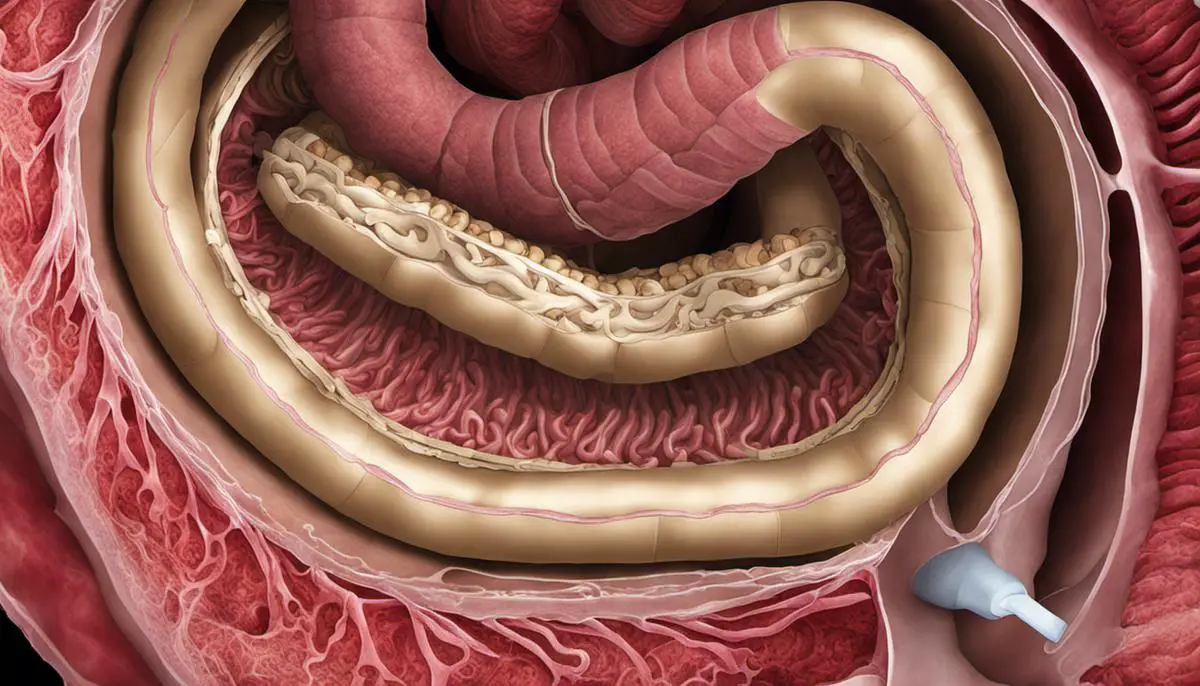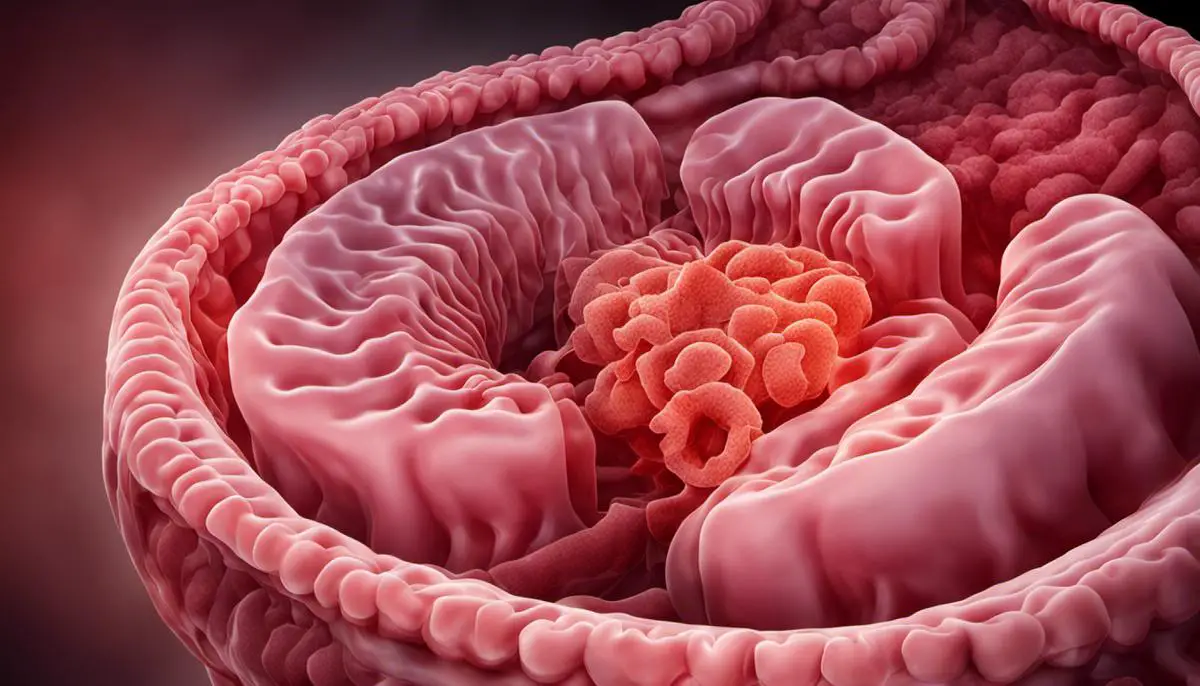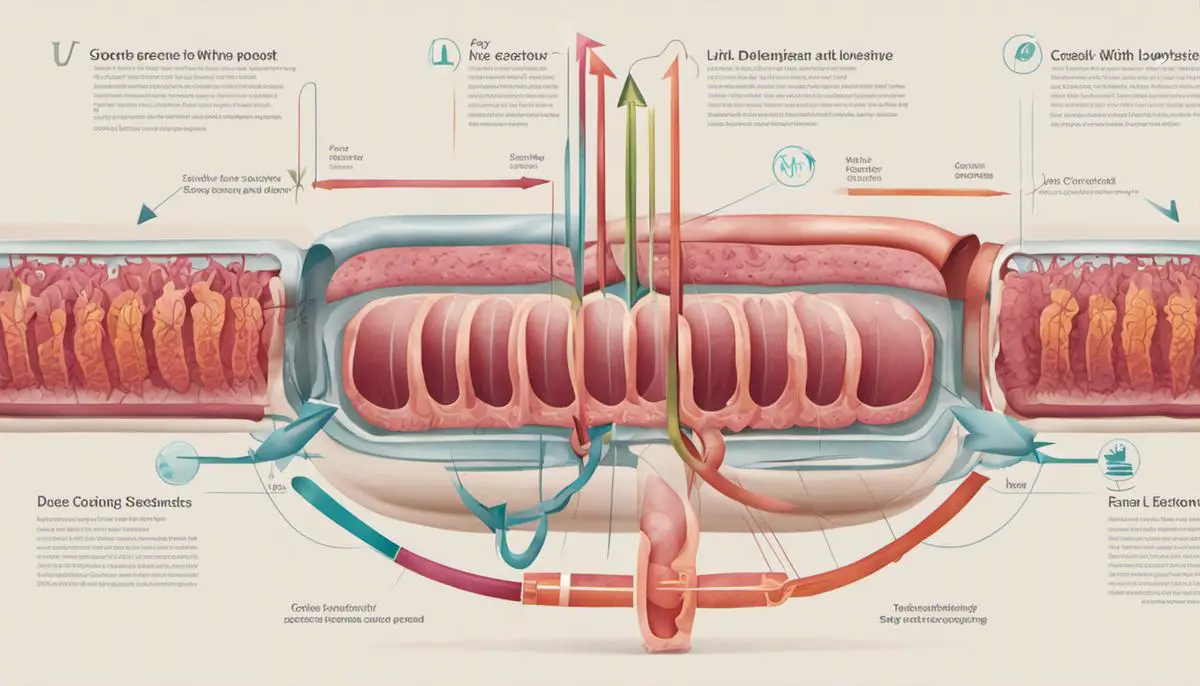Understanding the complexities of the human body and its potential health challenges necessitates diving into topics such as bowel obstruction. A health condition that can present severe complications if not promptly attended to, bowel obstruction happens when the normal flow of intestinal contents is blocked, causing innumerable discomfort and potential dangers to life. This broad understanding of bowel obstruction is vital as it lays the foundation for the necessity of knowing its causes, implications, and mitigation strategies.
Definition and Overview of Bowel Obstruction
Definition and Overview of Bowel Obstruction
Bowel obstruction, also known as intestinal obstruction, describes a situation where a blockage prevents food or liquid from passing through your small or large intestine. When this blockage happens, it hinders the normal movement and progress of digested food through your intestines, which can lead to severe health complications if not swiftly attended to.
Understanding Bowel Obstruction
In a healthy digestive system, digested food moves through the intestine mainly due to the rhythmic contractions of the intestinal muscles, a process known as peristalsis. These muscles squeeze and relax in a co-ordinated, wave-like manner, pushing food forward. However, a bowel obstruction can impede this natural progress, leading to an accumulation or stagnation of material in the intestines.
The obstacle that causes bowel obstruction might be due to a physical blockage known as a mechanical obstruction or a functional obstruction triggered by a malfunction in the body’s nerve or muscle function. In either case, the result is a back-up of digested food, air, fluids and gastric acids, which can lead to a bloated feeling, vomiting, pain, and ultimately, damage to the bowel tissue.
Prevalence of Bowel Obstruction
It’s worth noting that bowel obstructions are a relatively common cause of hospital admission. In the United States, approximately 15 out of every 100,000 people are affected each year and this condition can occur in individuals of any age and gender.
Importance of Knowing Causes of Bowel Obstruction
Understanding the root causes of bowel obstruction is critical as timely and appropriate treatment depends on the cause. Bowel obstruction can lead to serious, life-threatening complications if left untreated, while early identification and treatment significantly improve the prognosis.
Understanding the Causes of Bowel Obstruction
Bowel obstructions are often the result of various underlying conditions such as adhesions, diverticulitis, hernias, Crohn’s disease, certain types of cancer, and specific medications known to cause constipation. Adhesions frequently occur after surgery as part of the body’s natural healing process, although they can sometimes result in the abdominal tissues sticking together, leading to obstruction. Furthermore, diverticulitis, an inflammation or infection in the small pouches formed along the intestine, can cause obstructions.
Physical anomalies such as hernias can also lead to bowel obstruction. They occur when a weakened spot in the abdominal wall allows a portion of the intestine or other tissue to protrude, subsequently blocking the bowel. Crohn’s disease, a form of inflammatory bowel disease, may result in strictures or narrow areas within the bowel that can trigger obstruction.
Additionally, certain types of cancer, whether originating from the bowel or nearby areas, can cause obstruction if they interfere with bowel movement. Lastly, certain long-term use of medications, particularly some antidepressants or narcotics, could lead to severe and prolonged constipation, potentially causing bowel obstruction.
The crucial thread in managing bowel obstruction lies in the early recognition of symptoms and securing timely medical attention.

Different Types of Bowel Obstruction
The Concept of Mechanical Bowel Obstruction
Mechanical bowel obstruction emerges when there is a physical blockage within the intestines. This condition usually occurs when an obstruction in any part of the digestive tract such as the bowel, stomach, or small intestine, hinders the orderly passage of digested food. Various factors can cause mechanical obstructions including tumors, hernias, gallstones, or specific diseases like Crohn’s disease already mentioned above as a cause of bowel obstruction. These health issues often cause inflammation or swelling, resulting in constriction within the intestines and inhibiting the smooth passage of digested food.
Symptoms and Complications of Mechanical Bowel Obstruction
The symptoms of a mechanical bowel obstruction often include severe abdominal pain, vomiting, the inability to pass gas or move the bowels, and bloating. A rapid heart rate and increased respiratory rate can also be signs. Long-term or untreated obstructions can lead to serious complications like ischemia, where the intestines get insufficient blood supply, infections, tissue death, or even a perilous condition know as peritonitis, where the lining of the abdominal cavity becomes inflamed due to bacteria leakage.
Non-mechanical Bowel Obstruction
Non-mechanical bowel obstruction, also known as ileus, is caused by a malfunction in the nerves and muscles in the intestines. This disruption in function impedes the normal movement of food and fluid through the intestines. An ileus can occur from a number of conditions like an electrolyte imbalance, an infection or a side effect of some medications. Sometimes, ileus can be triggered by a recent surgery, particularly abdominal or pelvis surgery, as these can cause temporary cessation of intestinal movement.
Symptoms and Complications of Non-mechanical Bowel Obstruction
The symptoms of a non-mechanical bowel obstruction are often similar to those of mechanical obstruction. Patients might experience abdominal distention, cramps, nausea, and vomiting, along with the inability to have a bowel movement or pass gas. If not addressed promptly, an ileus can escalate into a serious condition like a colon perforation, sepsis, or at worst, death.
It is paramount to recognize and swiftly act upon any symptoms associated with bowel obstructions to sidestep devastating complications. The promptness of medical intervention can substantially lower the threat of severe consequences and potentially save lives, particularly in cases of both mechanical and non-mechanical bowel obstructions.

Primary Causes of Bowel Obstruction
Understanding Bowel Obstruction
Bowel obstruction, alternatively known as intestinal obstruction, manifests as a blockage in the digestive tract impeding the regular transit of intestinal contents. Depending on the underlying condition, the obstruction can be partial or absolute. Having a thorough knowledge of the causes of bowel obstruction is significant, as it directly impacts the therapeutic approach.
Main Causes of Bowel Obstruction
There are several primary causes of bowel obstruction. One of the most common is adhesions, which are bands of fibrous tissue that can form in your abdomen after a surgery. They’re invasive and can cause your bowel to twist or create a pull leading to an obstruction.
Diverticulitis is another common cause. This condition inflames or infects small pouches called diverticula that develop along the walls of the intestines. The inflammation or infection can result in blockages of the intestine.
Hernias, particularly those in the abdominal area, can also lead to bowel obstruction. Hernias occur when a weak spot in the abdominal wall allows a part of the intestine or other tissue to slip through, often creating a painful lump. If the hernia is strangled (if the supply of blood to the herniated tissue is cut off), it can cause bowel obstruction.
Certain cancers, particularly colon cancer, can also cause bowel obstruction. Tumors can grow large enough to block the passage of the intestine. Obstruction can also occur if a tumor spreads to the intestines from another part of the body, like the stomach or lungs.
Finally, inflammatory bowel diseases like Crohn’s disease or ulcerative colitis can lead to chronic inflammation and scarring of the intestine, which can ultimately cause obstruction.
Impact Across Age Groups, Genders, and Health Conditions
Bowel obstruction can affect anyone, regardless of their age, gender, or overall health condition. However, its prevalence can vary based on these factors.
For example, older people are more likely to experience bowel obstruction due to diverticulitis because the prevalence of this condition increases with age. Similarly, people who have had abdominal or pelvic surgery are more likely to experience obstruction due to adhesions.
Certain health conditions can also increase the risk of bowel obstruction. For example, people with Crohn’s disease are at a higher risk because this condition can cause chronic inflammation in the intestines.
There is no significant gender difference in the prevalence of bowel obstruction. However, certain factors, such as gynecological surgeries, which are more common in women, can increase the risk of adhesion-related obstructions among women.
Understanding the Prevalence of Bowel Obstruction
Bowel obstruction is a relatively prevalent health issue that is responsible for approximately 15 percent of hospital admissions related to gastrointestinal diseases. The incidence of this condition can vary, hinging heavily on its root causes. Bowel obstructions that arise from conditions like hernias or adhesions are common post abdominal surgery. On the other hand, obstructions attributable to cancers or inflammatory bowel diseases may become evident over an extended period.

Diagnosis and Treatment of Bowel Obstruction
Delineating the Diagnosis Process for Bowel Obstruction
Diagnosing a bowel obstruction typically involves a structured methodology comprising a physical examination, analysis of medical history, and numerous diagnostic tests. During a physical examination, the healthcare practitioner may palpate the abdomen to pinpoint any areas featuring tenderness, swelling, or rigidity. Symptoms like intense abdominal pain, cramping, vomiting, inability to pass gas or chronic constipation could signal a potential bowel obstruction.
Healthcare professionals frequently rely on diagnostic imaging to corroborate the presence of a bowel obstruction. Techniques such as abdominal X-rays, computerized tomography (CT) scans, and ultrasounds can visually expose blockages in the bowel. These diagnostic tools are invaluable for locating the obstruction, determining its cause, detecting signs of perforation or ischemia, and identifying any subsequent complications. In addition, blood tests might be administered to gauge the overall health of the patient, and to what extent, if any, infection is present, and to keep electrolyte levels in check.
In certain instances, a more detailed examination may be required, employing the use of flexible sigmoidoscopy or colonoscopy. These procedures involve inserting a slender, flexible tube fitted with a light and camera via the anus into the colon, allowing a thorough inspection of its interior.
Causes of Bowel Obstruction
There are numerous potential causes of bowel obstruction. Adhesions, or bands of scar tissue that form in the abdomen following surgery, are the most common cause. Other causes can include hernias, Crohn’s disease, diverticulitis, tumors or cancers in the colon or rectum, volvulus (twisting of intestine), or intussusception (one part of the intestine slides into another part).
Tackling Bowel Obstruction: Key Treatment Strategies
When considering the most effective treatment for bowel obstruction, the primary aspects to examine are the cause and severity of the issue. Numerous non-surgical solutions may be apt for partial obstructions or when particular conditions are responsible for the obstruction. These solutions can involve the use of nasogaic tubes – inserted through the nose into the stomach, to relieve pressure and drain fluids and gas, or the use of enemas and water irrigations to clear blockages.
In numerous scenarios, surgical intervention is deemed necessary. This way, the obstruction might be removed, damaged sections of the intestines could be repaired, or alternative pathways may be created around the blocked area. Techniques like minimally invasive laparoscopic procedures may be utilized, while in severer cases, open abdominal surgeries might be required.
When bowel obstruct is triggered by a tumor or cancer, treatment may demand radiation therapy or chemotherapy to shrink or eliminate the tumor.
The likelihood of success, risks, and benefits of these treatment technologies depend heavily on individual patient conditions, the cause of the obstruction, and how extensive it is. Despite this, accurate and timely diagnosis coupled with effective treatment can notably improve patient prognosis and minimize the chance of severe complications.

Preventive Measures and Lifestyle Adjustments
Mitigating Risk of Bowel Obstruction through Dietary and Exercise Practices
In connection with diet, consuming fiber-rich foods helps in staving off bowel obstruction. Regular intake of fruits, vegetables, whole grains, and legumes leads to softened stool and added bulk, thus lowering the risk of constipation – a frequent precursor of bowel obstruction. Also, it’s essential to note the significance of staying adequately hydrated since fluids aid in stool softening.
Physically active individuals benefit from a well-functioning digestive system that supports consistency in bowel movements and decreases the time waste spends in your intestines. Any regular physical exertion, whether brisk walking, cycling, or simple gardening, contributes towards reducing the chance of bowel obstructions emerging.
Managing Health Conditions and Bowel Obstruction Risk
Various health conditions can increase the risk of developing bowel obstructions. Abdominal or pelvic surgery can lead to scar tissue that causes obstructions, while diseases like Crohn’s disease or cancer can cause inflammation or tumors that block the bowel.
Effective management of these conditions is necessary to reduce the risk of bowel obstruction. Regular medical check-ups ensure that any changes in your health, such as new or worsening symptoms, are promptly addressed. Consistent medication usage as prescribed and proactive lifestyle adjustments, such as diet and exercise, can reduce disease impact and prevent complications like bowel obstruction.
Recognizing Symptoms and Seeking Medical Advice
Familiarity with the key symptoms of bowel obstruction can lead to early detection and prompt medical intervention, reducing the risk of serious complications. Symptoms may include abdominal pain, bloating, constipation, diarrhea, vomiting, and inability to pass gas.
Seeking immediate medical advice when experiencing these symptoms is crucial, as bowel obstruction can lead to life-threatening complications if left untreated. Regular communication with your healthcare provider is also key. Regular check-ups and discussing any relevant family history of intestinal problems can enable the healthcare provider to provide individualized advice and preventive measures.
In conclusion, prevention and early detection of bowel obstructions often involve lifestyle modifications (diet, exercise), regular medical check-ups, proactive management of existing health conditions, and prompt response to symptoms. Following these strategies can significantly reduce the risk of developing this potentially serious condition.

While bowel obstruction can be a daunting health condition to confront, it’s vital to understand that with adequate knowledge about preventive measures and lifestyle modifications, its occurrence can be mitigated. Simultaneously, knowing when to seek medical advice can make a profound difference in treatment success. Thereby, raising the awareness and understanding of this condition can empower individuals, helping them to make informed choices about their health, ultimately leading to better management, and hopefully, a decrease in the prevalence of bowel obstruction.
